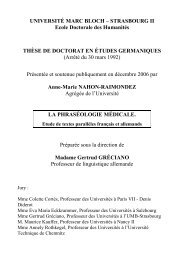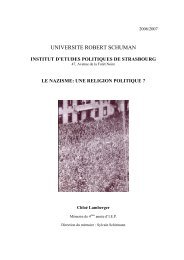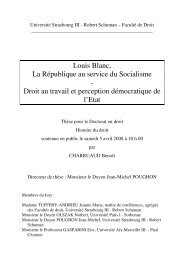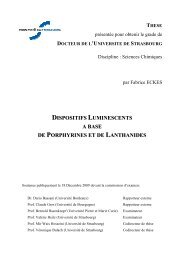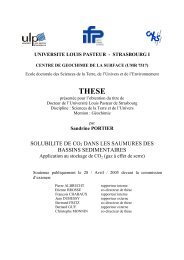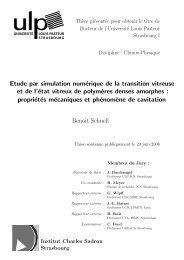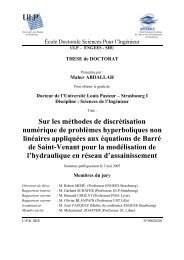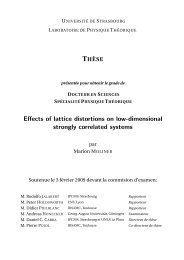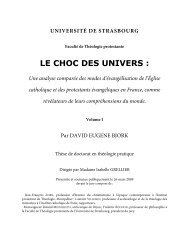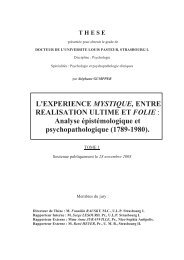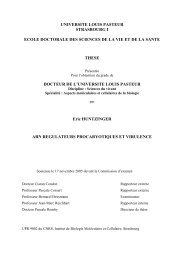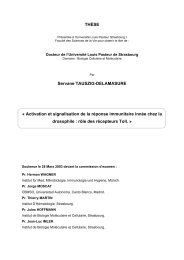Anthony KERMAGORET - THESES ET MEMOIRES DE L'UDS
Anthony KERMAGORET - THESES ET MEMOIRES DE L'UDS
Anthony KERMAGORET - THESES ET MEMOIRES DE L'UDS
You also want an ePaper? Increase the reach of your titles
YUMPU automatically turns print PDFs into web optimized ePapers that Google loves.
Chapitre IV<br />
In contrast to complex 20 which has phenyl substituents on the phosphorus atom,<br />
complex 22 has tert-butyl groups and their steric and electronic donor effects significantly<br />
affected the catalytic results. Under standard conditions, precatalyst 20 led to a low<br />
selectivity for 1-butene (less than 11% of the C4 fraction), which is characteristic of an<br />
isomerizing catalyst, and to a high concentration of C6 oligomers formed by reinsertion of 2-<br />
butene (up to 68%, Table 6). In contrast, 22 did not favor the isomerization of 1-butene and<br />
had a selectivity up to 42% for 1-butene within the C4 fraction. However 22 led overall to a<br />
low selectivity in C4 products (less than 23%) owing to the reinsertion of 1-butene to form 2-<br />
ethyl-1-butene (up to 77%, Table 6) and presented a very different mass distribution of<br />
oligomers compared to 20 (Figure 10). Heinicke et al. have observed similar effects with<br />
cationic methallylnickel phosphinophenol complexes where cyclohexyl substituents on the<br />
phosphorus donor function favored the formation of 2-ethyl-1-butene, in contrast to the<br />
phenyl substituents which favored the formation of cis-3-methyl-2-pentene. 72<br />
When the quantity of precatalyst 20 and 22 was decreased to 10 -5 mol, very high<br />
activities were still observed. Under these conditions, 20 showed a slightly better selectivity<br />
for C4 products and 22 a slightly higher selectivity for 1-butene.<br />
Increasing the pressure to 30 bar resulted in increased catalytic activities with 20 and<br />
22, from 30100 to 36800 mol C2H4/(mol Ni·h) with 20 and from 24200 to 45500 mol<br />
C2H4/(mol Ni·h) with 22. It has been shown with related systems that TOF can be<br />
independent or not on ethylene pressure. 20,70 In the former case, the alkyl olefin species is the<br />
catalyst resting state. 73 According to the literature, 20 a higher ethylene concentration favors<br />
the formation of α-olefins and the selectivities for 1-butene with 20 (34%) and 22 (73%)<br />
were indeed higher. The selectivity for C4 products with 20 increased to 93% (Table 5) but<br />
the mass distribution of the oligomers produced by 22 did not change. The high<br />
concentration of 1-butene resulted in a marked increase of the concentration in 2-ethyl-1-<br />
butene (up to 91%). These rather surprising results with 22 suggest that the tert-butyl<br />
substituents on the P donor atom favor the formation of 1-butene and that its isomerization to<br />
2-butene is disfavored with respect to formation of the C6 product 2-ethyl-1-butene. One<br />
could envisage that the latter originates from unselective insertion of 1-butene into the Ni-<br />
ethyl bond of a primarily formed intermediate 72 (Scheme 3, route A) or by β-elimination of a<br />
metallacyclic intermediate resulting from the coupling of 1-butene with ethylene (Scheme 3,<br />
route B). Ni(II) metallacyclic compounds have been previously considered in olefin<br />
chemistry. 74<br />
19



